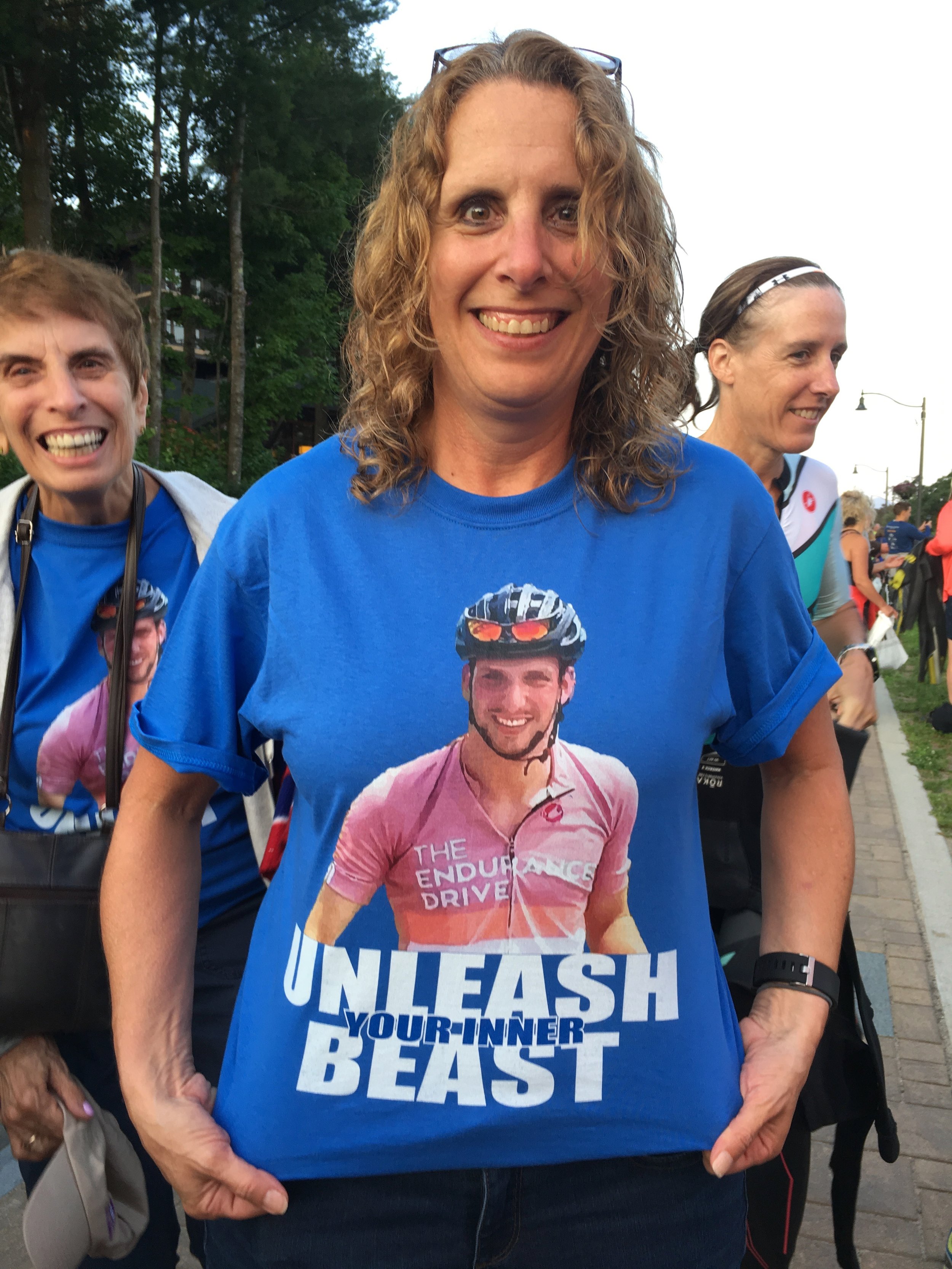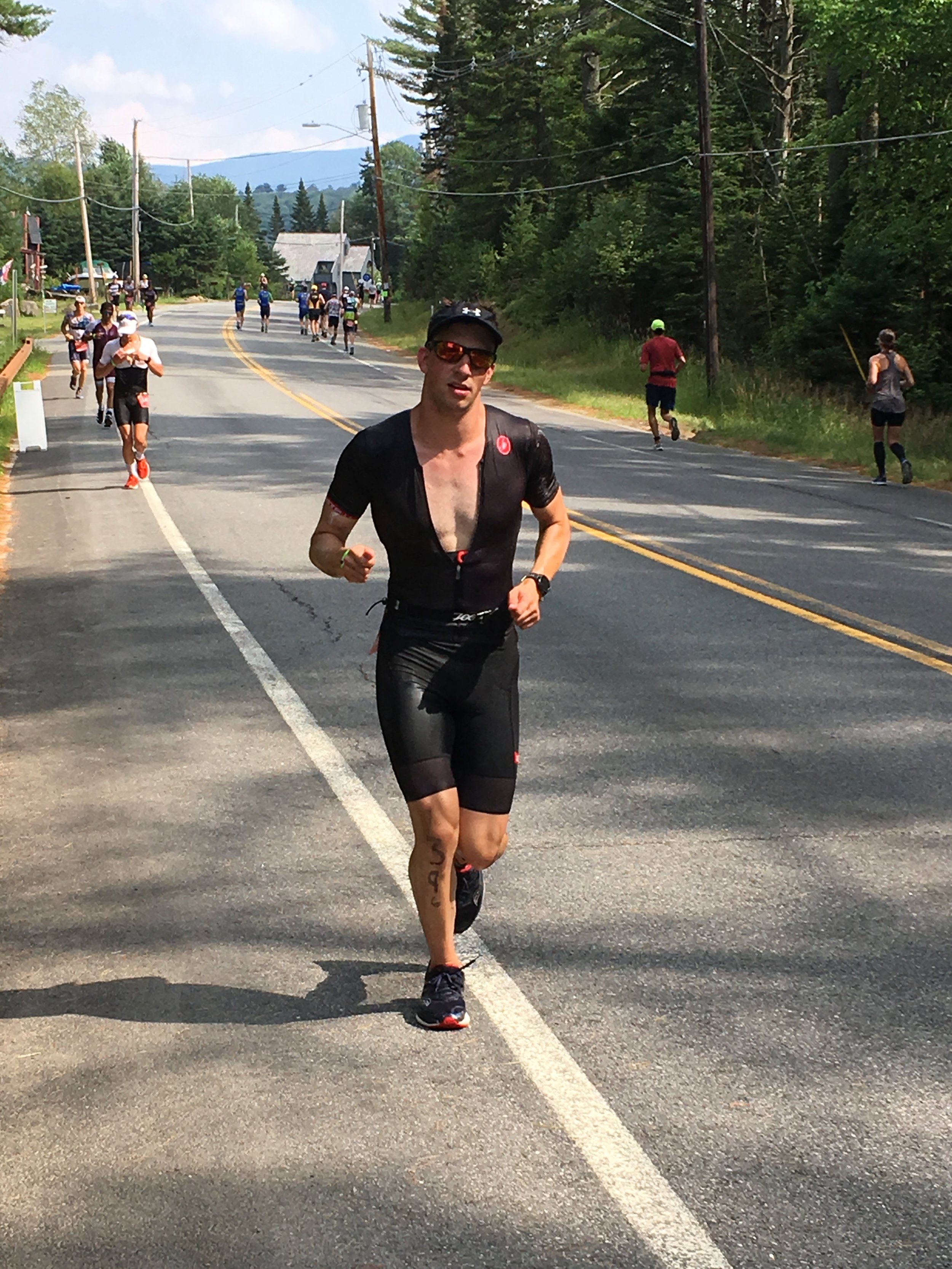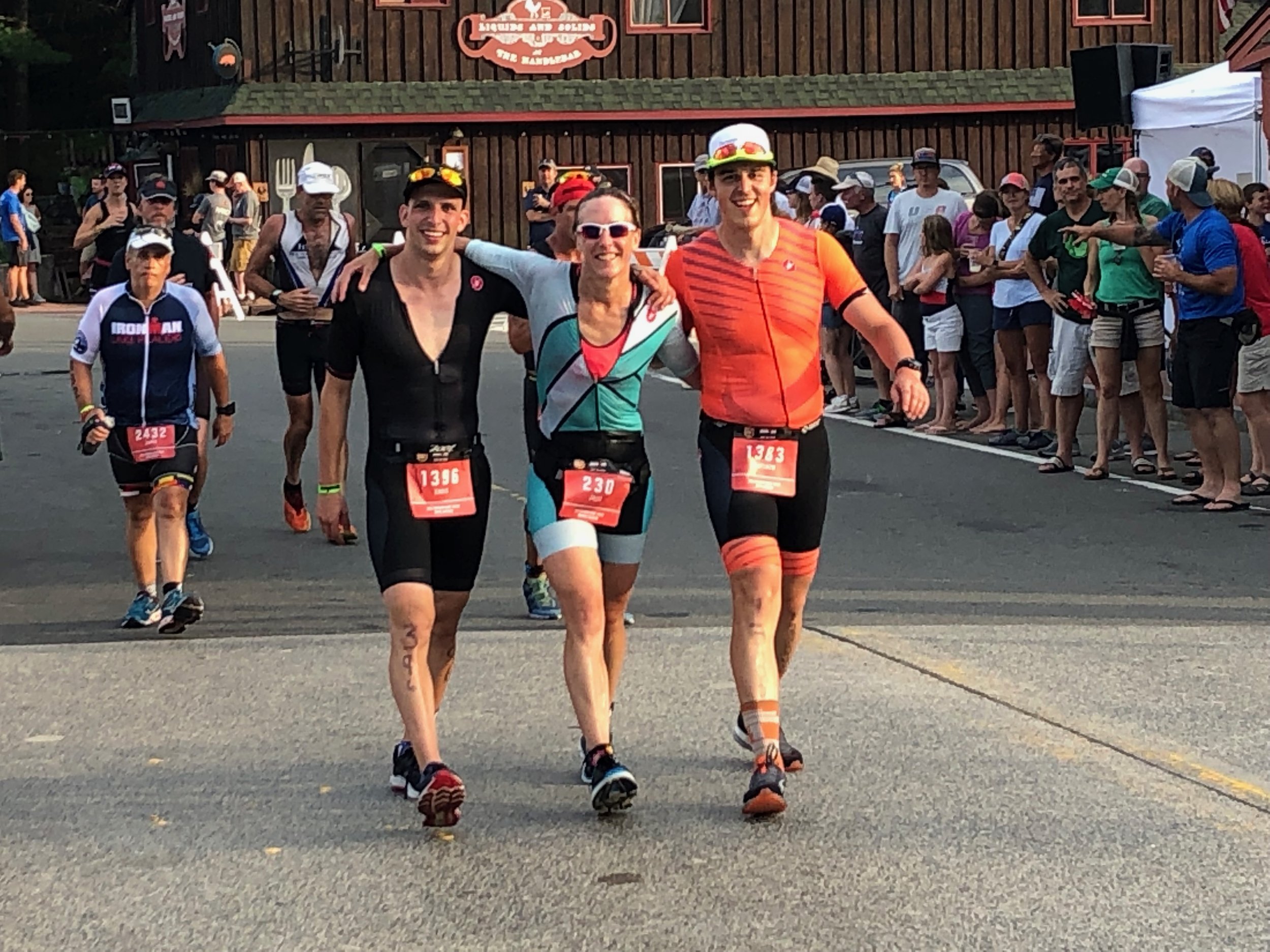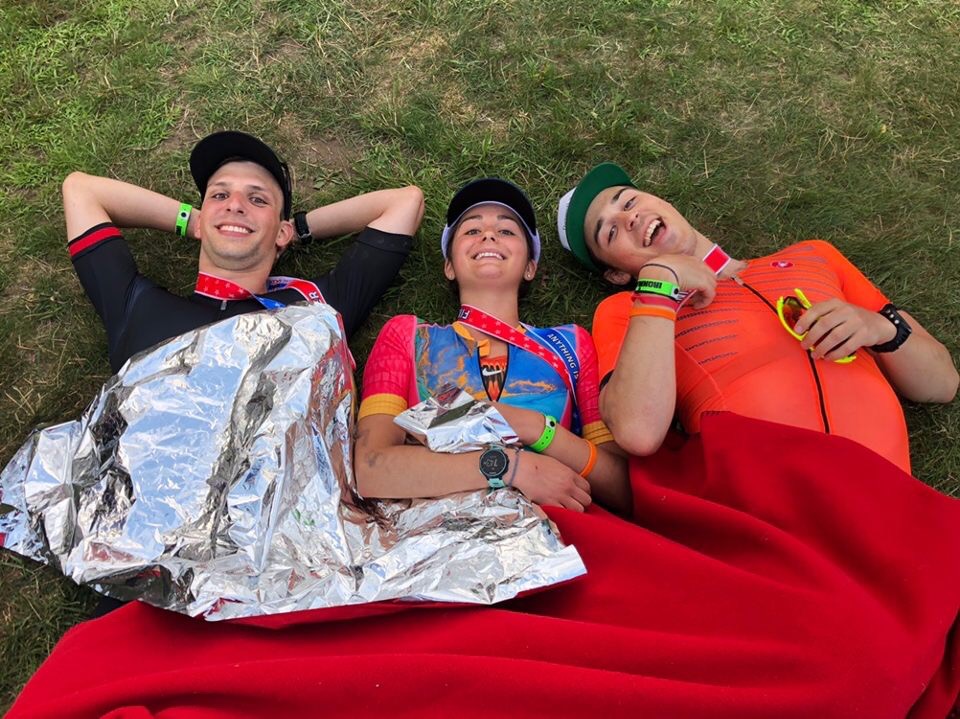Expectations and Pre-Race Thoughts
Ironman Lake Placid (IMLP) had the distinction of being both my A-race and my first race of the season. After taking a year off from triathlon, I had been feeling anxious to get back into race mode. I was also excited to see the results of actually training for a triathlon. Coming off a collegiate swimming career, I had previously relied on endurance from distance training and natural fitness to get me through triathlons. This was my first time working with a coach, and I knew that my training over the last seven months was well thought out. I was ready.
The Plan
Swim. Approximately 1:00 – 1:05 on the swim. Be aggressive, but do not expend any energy. If possible, find someone at a similar or slightly faster pace and draft off them to conserve energy. Keep the cable in sight. Use the swim to get the pre-race jitters out of the way.
Bike. Maintain a normalized power of 160-170 for the bike. Keep heart rate under 150 bpm, but ideally closer to 140 (or lower). Keep head position steady. Eat every 20 minutes, and drink at least every 10.
Run. Cap HR at 155, but try to stay between 140-150. Do not blow out the energy in the first few miles – it’s a long race. Maintain hydration. Hope that the leg cramps decide not to show up today.
Nutrition. I used Science in Sport (SiS) electrolyte powder, carbohydrate bars, and gels.
Swim
Although my goal swim was in the low 1:00 mark, I placed myself in the sub 1:00 group. IMLP’s swimmers have a reputation of seeding themselves faster than they will actually finish, and so I wanted to get ahead of any athletes who were a bit…overeager. Additionally, I wanted to get ahead of the mass pack which would no doubt involve a fair amount of aggression as swimmers would jockey for a spot on the cable.
The first 1000 yards went off like any other open water swim. There was a fight for position during the first 500 yards as the lead bunch formed into a pace line. Rounding Turn 2 (~1000 yds), I made my only ‘mistake’ of the swim when I got too comfortable with the reduced need to spot and overshot the turn by about 20 yards. Not a big deal, but it was a fitting mistake considering that a sense of direction was never my strong suit.
I was able to find a swimmer slightly faster than me to draft behind for the second 1000 yards. This was my strategy going into the swim, and I was able to stay on his feet for most of the straightaway. I was surprised by how many people were swimming off the cable – some by over 25 yards to the left. Yes, this would reduce the traffic they would encounter, but swimming away from the pack seemed unnecessary given that we were still on the first lap and had clear, open water in front of us.
Lap 1: 29:14
The first half of the second loop went about as well as the second half of the first loop. Although I continued to draft off the guy ahead of me, we were caught by a chase pack which had engulfed the two of us by buoy 5 (~2900 yds). For context, the IMLP swim course is a rectangle with eight yellow buoys on the way away from the start, two red buoys to mark the turns at the other end of Mirror Lake, and eight orange buoys on the way back to shore.
By the time our group rounded Turn 2 and was on the homestretch, I encountered probably the hardest challenge of the swim: the slower age groupers. The open water quickly devolved from an organized pace line to an ‘every-man-for-yourself’ maelstrom. Sighting was required, but mainly to look out for other swimmers rather than check if we were on course. I had to figure out who was ahead of me, if there were gaps to shoot, and if it was easier to swim through or swim around the athletes ahead of me. As rushed as it may seem, that chaos is one of my favorite things about open water swimming – it requires more thinking and aggression than swimming in a pool.
Before long, I saw an orange buoy with an “8” followed by a red buoy with a T3, meaning I had reached the end of the lap. I was feeling really strong, not out of breath, but strong. The race was on.
Lap 2: 30:14
Total Swim: 59:14. 1:00 goal complete.
Transition #1
The transition involves a long-ish run (at least a quarter mile) from Mirror Lake to transition. This was the first time I had ever used a wetsuit stripper (and the first time I had ever used a wetsuit), and so the process of being told to lie down on the ground as a volunteer yanked my wetsuit off my legs in one smooth motion was interesting, but efficient. I entered transition, grabbed my bike gear bag, and ran into the changing tent.
The volunteers were great, and I was fortunate to be in the changing tent with relatively few athletes (most were still in the water). While I was putting on my socks, shoes, and rubbing some chamois cream on my thighs, the volunteer was getting my glasses, helmet, and gloves ready to go. Transition times were significantly slower than every other triathlon I had previously done. What I thought was a really slow transition was actually 5th in my AG. Taking an extra minute or two in the changing tent doesn’t mean too much in a 10+ hour race.
Transition 1: 6:03
Bike
I read a sentence on a blog post somewhere which stuck with me throughout my longer training rides: “In Ironman, do the bike you should, not the bike you could.” I knew it was important to keep a consistent pedal stroke and monitor my power output, but I also wanted to ride a race I could be proud of. This meant that I would race to my plan: not an easy ride, but not an over-aggressive ride that would destroy my run.
The climbs out of Lake Placid are inconspicuously long, and I’m thankful that I came out in June to practice the course as I knew to take this section slow and smooth. I saw a few cyclists absolutely pounding the opening hills, and I remember thinking that they were insane – we still had 9 more hours of racing left!
The downhill screamer to Keene is one of my favorite parts of the course. I hit a new speed record for the year, and it was nice to have a section where I could bank some free miles. Then came the flats to Wilmington and soon, the severely underrated climb out of Wilmington. Again, some bikers were flying up the hill looking like they were cranking more watts than a professional cyclist on a hors catégorie mountain. Later, I saw several of them walking on the marathon…
Even on the long climb back to Lake Placid, I was feeling good – much better than I was expecting. My power was at my goal watts, my body was feeling fine, and I was hitting my nutrition. When I rode into Lake Placid, I looked down at my computer to mark the lap and saw a 2:54 – more than 20 minutes faster than my anticipated lap split (3:15). Rather than excitement, this actually caused a good deal of anxiety starting the next lap, and I worried I had killed the rest of my race by taking the first lap too aggressively. But I was still feeling strong, I was having fun, and the crowds were cheering me on through town. Riding down Mirror Lake Drive, I pounded my chest and yelled with the crowd, rejuvenated by the energy of the spectators lining the streets. I saw my parents, grandparents, and a friend from college who came up to watch me race, all recognizable by their matching blue shirts with a picture of me printed on the front. The anxiety quickly disappeared.
Lap 1: 2:54
Chris Klein IRONMAN Lake Placid family t-shirt
But sure enough, the problems started on the second lap. Earlier than in my training runs, my body started to reject the carbohydrate bars I was eating, and my electrolyte drink seemed less and less appealing with every sip. I started missing scheduled eating and drinking periods. On what began as a cloudy day, the sun started to break through the clouds, and brought with it rising temperatures on the exposed roads.
Finally, on the climb passed Whiteface, I cracked. My quads cramped up several times, requiring me to pull over to the side of the road and try to massage them out. But worse than the cramps, massive headwinds, absent on the first lap, hampered any forward progress I was making when I would resume my rides. My two training partners, Matt and Katie, both passed me as I was trying to massage out a cramp, and, truth be told, I took relief in seeing familiar faces. Although I appreciated the “are you ok?’s” from concerned cyclists as they rode passed me parked on the side of the road, it was a little demoralizing recognizing that I still had to make it to Lake Placid in order to even start the run.
After finally getting back on my bike, Mile 100 is where I hit my low point. I was well aware that mental toughness was necessary to finish this race strong, but I was not expecting to have my attitude tested so early in the day. After what seemed like an eternity, I finally got to the top of the Northwood Road climb (the short, sneaky climb after the three bears) and enjoyed the coast to transition. Even with the pain, I still finished the lap ten minutes over my anticipated lap split.
Despite all of the negative emotions mentioned in the previous three paragraphs, I was still having fun. In a sense, nothing was awry…yet. Ironman is a hard race, plain and simple. I knew I was going to struggle with the bike, and although it wasn’t perfect, I made it. Every problem I encountered, I anticipated and had a plan. Race day preparation is an undervalued benefit of having a coach, and as a result, panic mode never set in. Instead, I was ahead of schedule, I was faster than my training rides, and I was still feeling strong enough to run a marathon. Furthermore, I wasn’t hurting alone. Pictures may speak louder than words, but facial expressions in Ironman are an open book for describing how an athlete is feeling. Based on the emotionless faces and glassy, empty eyes, my pain was in good company.
Lap 2: 3:23
Total bike: 6:17. 6:30 goal complete
Transition #2
After crossing the dismount line and handing my bike off to a volunteer, I decided that the path to the changing tent was more deserving of a walk than a run. My legs were hurting, and all I could think about was getting out of my biking shoes. In the tent, I took off my helmet, swapped my socks and shoes, threw a bag of sodium gels in my pocket, quickly downed some fluids, and headed off on my run. Just like in Transition 1, I thought I was moving slowly in T2, but my time was actually above average for age groupers.
Transition: 5:43
Run
Despite all of the pain I had felt during the last 20 miles of the bike and heading into transition, I actually felt great for the start of the run. I set my watch to focus solely on my heart rate. I used the opening downhills to lengthen my stride and stretch out my quads and calves. I was moving, and with my speed came energy – I was back to having fun!
One aspect of the race I haven’t touched on too much yet is the crowds. I’ve never seen more support in a race than from the fans and volunteers in Lake Placid. Coming out of transition, I heard more cheers of “let’s go” and “come on, Chris” than in all of my previous races combined. It felt very personal, like they were cheering for me instead of the usual casual clap as spectators wait for their athlete(s) of focus. There were also the fans who tried to be more…unique. The spectator on the ski jump hill at Mile 2/9/15/22 who high-5’d everyone with Facebook foam fingers. The fraternity squad at Mile 1/10/14/23 who cheered for everyone while parading around in their underwear. The aisle of fans on Mirror Lake Drive who tried to motivate the nutrition-depleted runners as they “death marched” to the completion of their first lap. Their energy was contagious and set a new standard that I fear will never be matched by another race nor another crowd.
But outside of Lake Placid and down Riverside Drive (Miles 3-9 and 16-22), spectators could not easily watch the race and the non-athletes were limited to the volunteers working at aid stations and the medical tent. The lack of cheering fans shouting encouragement diminished the environment to the sight of expressionless runners trying to get to the next aid station and the sounds of running shoes shuffling down the road. The course, on the other hand, was shaded and pretty with the road running adjacent to a small stream.
Early in the run, I was still feeling strong. I was holding around 8:45’s but my HR was starting to rise, still within the 150 range. Many athletes had started walking (my assumption being those who tried to overdo the bike), and truth be told, the number of runners I passed in those opening miles was encouraging. I linked up with another runner who was holding my pace and we chatted for the next 5 miles until the run turnaround when the exhaustion finally caught up to him and he resorted to the ‘death march.’
For me, the struggle began around Mile 8. My heart rate had started to creep into the 150s and low 160s, and even though I eased my pace to 9:30’s, I had a hard time getting my heart rate to come down. I spent the aid stations trying to get as many calories and fluids as I could into my system – water, Gatorade, bananas, chips and pretzels, more Gatorade, more water, ice to hold in my hands and mouth – but my irregular nutrition patterns on the bike had started to wear me down. Mile 9 was the ski jump hill climb, and after walking up the hill I found I couldn’t engage my feet to run again. I was stuck. Then came the cramps: calves, quads, hamstrings, even my groin. My state could best be described by my stop at special needs (Mile 12) when I had a seven-year old volunteer named Gio and his dad help me change my socks. The cramping in my legs was so bad that I couldn’t move/engage the small tendons and muscles without my body wrenching in agony. One of my favorite pictures taken at Lake Placid was on the run where it looks like I’m laughing and shrugging my shoulders. In reality, my dad had yelled to me, “You’re almost there!”, to which I responded, “Dad, what are you talking about? I’m shuffling like a tap dancer, and I still have a half marathon to go!”
Lap 1: 2:07
The only aspect of the race for which I did not prepare was the amount of GI distress that I would encounter, and I do not think I could have prepared for that type of pain. From the start of the second lap, I felt sick, and I knew that throwing up would only deplete me of the electrolytes my body had yet to process and desperately needed. At Mile 14, I found Coach Jim on the course and even asked him if I should throw up – he advised against it. After 9.5 hours of work, my body was fighting back, and I was about to head back out to the isolation of Riverside Drive.
As it turns out, a bathroom break was really what I needed at the time, and when I came out of a porta potty at Mile 15, I saw Matt about 50 feet ahead of me looking like he was in a very similar condition as I was. We made a pact to finish the race together, and our pacing switched to three minutes of running/jogging/shuffling followed by one minute of walking. Between the GI distress and the ever-present leg cramps, the hurt was real. We both knew the key to finishing was to keep moving, even if it meant a slow walk. Looking around us, the ‘death march’ present on the first lap had evolved to a ‘death march of zombies,’ but the three minutes of running/consistent movement and the mental relief of running with a training partner gave me the strength to keep going. Around Mile 21, Matt and I were joined by Julie Smith, another Upper Valley triathlete, and the motivation and positive encouragement present in the Upper Valley progressed the time, both physically and mentally.
Chris Klein, Julie Smith & Matthew Goff - IRONMAN Lake Placid run
As we climbed back into Lake Placid, the crowds brought us to the finish line. Spectators lined Main Street and Mirror Lake Drive, and the high-5’s and screaming fans were moving. My legs were starting to give out from the cramping, and Matt waited for me to briefly massage them out while Julie finished her own race. From the final aid station, Matt and I decided to make one final, consistent run to the finish line.
As we entered the Olympic speed skating oval, my emotions kicked in and I started tearing up. Every step brought back a memory from this year’s training, from my initial struggles with a six-mile treadmill run to my first bike over two hours. Unfortunately, I do not remember Mike Reilly saying my name as I approached the finish line – I was too busy taking in my surroundings. Matt and I put and arm around each other and crossed the line. We gave each other a hug. A volunteer put the medal around my neck. I bent down and allowed some tears to fall. The hardest race I had ever done was over. I found Katie, and she, Matt, and I took a group picture. My friend from college helped me out of the oval and up a hill to where some spectators had camped out, and I promptly fell into Jim’s arms in a half-hug/half-collapse. He kept repeating in my ear, “You are an Ironman, buddy.” After 45 minutes, I hobbled into the medical and massage tents to receive some much-needed care on my legs.
Lap 2: 2:52
Total Run: 4:59
Final Time: 12:39:44
Closing Thoughts
I allowed myself a week before attempting any sort of workout. After seven months on the grind, my body deserved a break.
Although I was hurting during the final part of the bike and most of the run, I do not regret many of my in-race decisions. Could I have eased off the power on the flats during lap one of the bike? Maybe. But then maybe I would have been hit with more of the headwinds. Should I have taken the opening miles of the runs easier? Probably. But my heart rate was in my target range. I finished in a competitive time, and I am proud of my accomplishment. I’m also proud to have finished the Lake Placid course for my first Ironman – those hills are no joke!
Now we know how to adjust the training if I were to race IMLP again. The majority of the training this year was spent building a fitness base. Now, the base is there, and I will improve my stability and power on the bike, and to add in some appropriate IM pace work on the run.
My next race, SwimRun Casco Bay, is soon, only two weeks after Lake Placid. I’m excited to incorporate some speed in place of aerobic work, and race in an event which combines my two stronger legs of a triathlon. Plus, a 13-mile race is much shorter than an Ironman. After that, Lake George Olympic, so the distances only decrease from here!
I couldn’t have finished this race if it wasn’t for the Endurance Drive tribe, and so a massive thank you goes out to Coach Jim & Endurance Drive teammates Matt & Katie.
Keep on driving – Chris Klein
Chris finished SwimRun Casco Bay with an overall second place finish in the solo division. Great work, Chris!
Chris Klein, Katie Clayton & Matthew Goff - post IRONMAN Lake Placid





